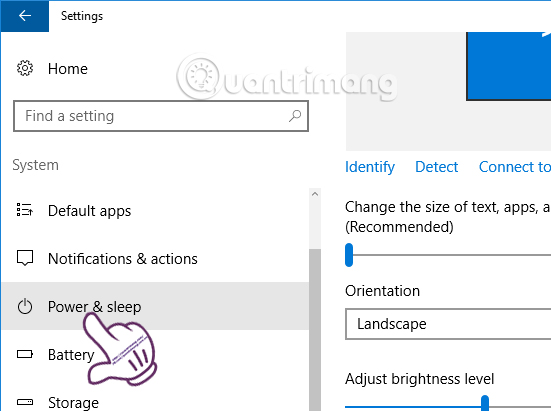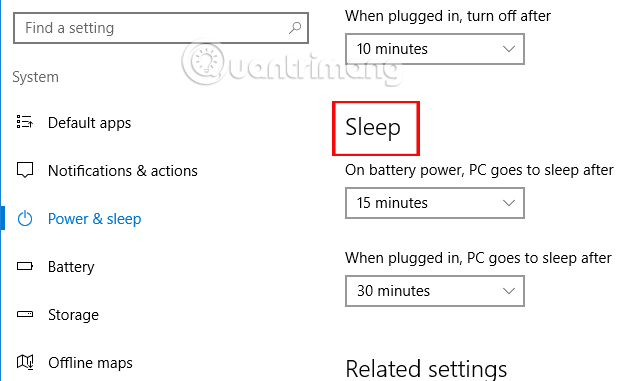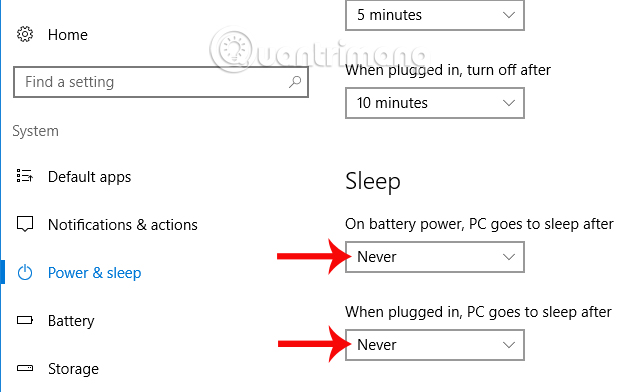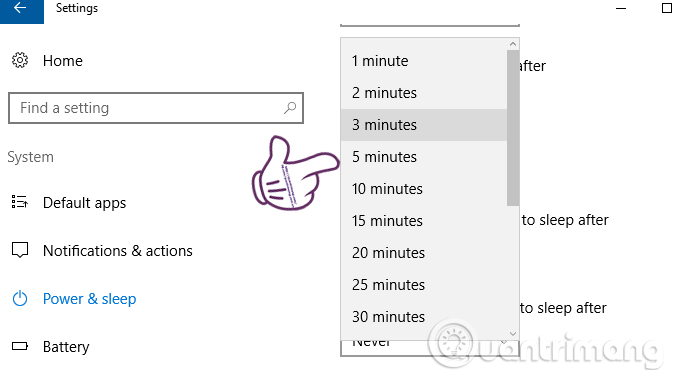To enable or disable Sleep mode in Windows 10
Sleep mode on a Windows computer will put the computer into an active state that consumes the battery at the lowest level. And on Windows 10, this mode is set to default. When a user does not use the computer for a period of time, Sleep mode prevents battery depletion.
Compared to Hibernation when the computer is completely idle, Sleep saves battery life but can continue to work on the computer, by pressing any key or hovering.
However, the problem here is the Sleep mode to the default setting, so it will automatically put the machine into Sleep state after a period of not using the device. Therefore, there are many cases where you are downloading data, the machine will automatically enter the Sleep state and must resume resume to download. The following article will help you to customize the time for Sleep mode, or you can disable Sleep Windows 10 mode if necessary.
Method 1: Turn on / off Sleep mode in Windows Settings
Step 1:
First of all, we will open the Windows Settings window interface by clicking Start menu and then clicking on the jagged icon . Or you can use Windows + I.

Step 2:
In the Windows Settings interface, continue to click System to set up the settings on the system.

Step 3:
Switch to the new interface, in the list on the left, click on Power & Sleep settings .

Step 4:
Switching to the interface to the right of the Sleep section will have options to set up for this mode, including:
- On battery power, PC goes to sleep after : when using the battery, the computer will automatically switch to Sleep mode after a period of 15 minutes.
- When plugged in, PC goes to sleep after : when plugged in, the computer will automatically switch to Sleep mode after about 30 minutes.

In case you want to turn off Sleep mode, just switch to Never mode .

Or if you want to change the time to put in the Sleep state , we just need to select the time period that the list provides.

In addition, users can customize battery saving mode, screen brightness by clicking on the battery icon in the system tray.

Method 2: Customize Sleep mode in Power Options
Step 1:
At the search bar on your computer or Cortana, users enter the Power Options keyword . Then click on the results found as shown below.

Step 2:
In the Power Options interface, click on Change when the computer sleeps setting in the list on the left of the interface.

Step 3:
At the Edit plan settings interface, in the Put the computer to sleep section, it is set to Never in the default mode on 2 columns On battery and Plugged in.
To adjust the amount of time for a Windows computer to enter Sleep mode, click the arrow icon, and then select the time in the provided list.

The last step is to click the Save changes button to save any new changes to Sleep Windows 10 mode.

Adjusting Sleep Windows 10 mode helps your computer save battery power, while the computer is still working but we don't sit in front of the screen. Besides, users can also disable Sleep Windows 10 mode if desired.
I wish you all success!
You should read it
- How to fix Windows 10 automatically activating Sleep Mode
- How to set up a Windows 11 PC to automatically go to Sleep
- How to disable automatic Sleep mode on Windows 10?
- How to disable Sleep mode on Windows 11
- How to adjust the Sleep mode on Windows 7
- Ways to enable sleep mode on Windows 11 PCs
- Here are the 3 fastest ways to put your computer to sleep
- How to turn off Sleep mode in Windows 10/11
May be interested
- Here are the 3 fastest ways to put your computer to sleep
 you should put your windows pc to sleep (sleep) when not in use. with just a few simple steps, sleep mode saves battery life, ensures privacy and security, and can let you resume work quickly when needed.
you should put your windows pc to sleep (sleep) when not in use. with just a few simple steps, sleep mode saves battery life, ensures privacy and security, and can let you resume work quickly when needed. - How to enable and disable Game Mode on Windows 10 to optimize performance
 game mode on windows 10 helps optimize system resources, providing a smoother gaming experience. however, this feature is not always suitable for all games. this article will guide you how to enable/disable game mode easily and quickly.
game mode on windows 10 helps optimize system resources, providing a smoother gaming experience. however, this feature is not always suitable for all games. this article will guide you how to enable/disable game mode easily and quickly. - How to enable and disable the standby screen mode in Windows 10
 how to enable and disable the standby screen mode in windows 10. the screen saver (screen saver) is a feature that helps your computer operate with lower power but still ensures the computer turns on quickly when you return. work. this feature is extremely useful when we use the old crt monitors with a long boot time.
how to enable and disable the standby screen mode in windows 10. the screen saver (screen saver) is a feature that helps your computer operate with lower power but still ensures the computer turns on quickly when you return. work. this feature is extremely useful when we use the old crt monitors with a long boot time. - How to fix Windows 10 automatically activating Sleep Mode
 some computers running windows 10 fail to activate sleep mode by themselves, causing users to turn on the computer again. usually, this sleep mode error usually occurs due to settings on a windows 10 computer and we can handle it as follows:
some computers running windows 10 fail to activate sleep mode by themselves, causing users to turn on the computer again. usually, this sleep mode error usually occurs due to settings on a windows 10 computer and we can handle it as follows: - Instructions on How to Turn Off Windows 10 Sleep Mode Extremely Quickly
 sleep mode is a useful tool for those who often use computers. let's refer to the simple ways to turn off sleep mode win 10 below!
sleep mode is a useful tool for those who often use computers. let's refer to the simple ways to turn off sleep mode win 10 below! - How to adjust the Sleep mode on Windows 7
 sleep mode on windows 7 will help your computer save power, and restart your computer quickly when you click or press any key.
sleep mode on windows 7 will help your computer save power, and restart your computer quickly when you click or press any key. - How to turn off Sleep mode in Windows 10/11
 sleep mode on windows will put the computer into the lowest power consumption mode, extending the computer's battery life when the device is not in use.
sleep mode on windows will put the computer into the lowest power consumption mode, extending the computer's battery life when the device is not in use. - Enable to limit blue light from PC and Mac computer screens to protect sleep - did you know?
 some researchers believe that light emitted by computers is the reason many people sleep less and sleep is not quiet. thankfully, there is a solution - the blue light restriction feature on pc and mac - that will help you get rid of this sleep deprivation.
some researchers believe that light emitted by computers is the reason many people sleep less and sleep is not quiet. thankfully, there is a solution - the blue light restriction feature on pc and mac - that will help you get rid of this sleep deprivation. - Activate the 'Write Protection' mode of USB on Windows 10
 you may not know but windows 10 allows to enable 'write protection' mode to protect usb storage devices. after this mode is activated, it will restrict write permissions on portable hard drive devices (usb drives, etc.). this is extremely useful, which is an additional security option on your system.
you may not know but windows 10 allows to enable 'write protection' mode to protect usb storage devices. after this mode is activated, it will restrict write permissions on portable hard drive devices (usb drives, etc.). this is extremely useful, which is an additional security option on your system. - How to enable or disable airplane mode on Windows 11
 airplane mode is a system setting option that when you enable it, all transmissions and receptions on the device will be completely disabled, along with a plane icon. flight appears in the status bar of the operating system.
airplane mode is a system setting option that when you enable it, all transmissions and receptions on the device will be completely disabled, along with a plane icon. flight appears in the status bar of the operating system.










 Instructions to enable password expiration in Windows 10
Instructions to enable password expiration in Windows 10 How to upgrade Windows S operating system to Pro version
How to upgrade Windows S operating system to Pro version Instructions for activating and customizing virtual Touchpad on Windows 10
Instructions for activating and customizing virtual Touchpad on Windows 10 How to add Quick Launch bar in Windows 10
How to add Quick Launch bar in Windows 10 How to hide files, show hidden files, view hidden folders and file extensions on Windows 7/8/10?
How to hide files, show hidden files, view hidden folders and file extensions on Windows 7/8/10? How to optimize the system Windows 10 Creators Update
How to optimize the system Windows 10 Creators Update